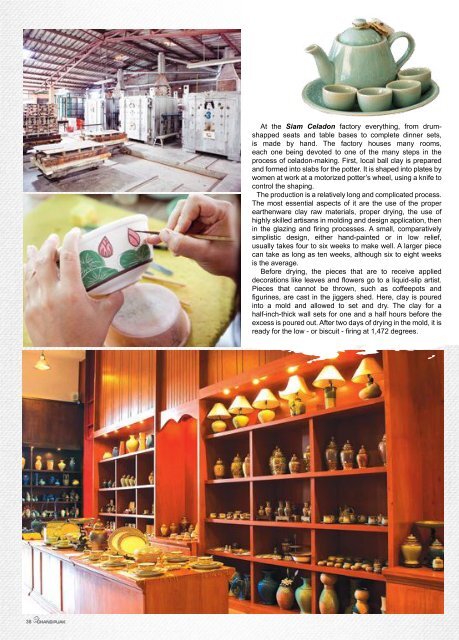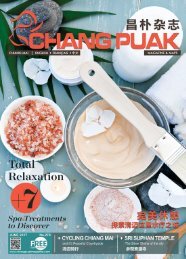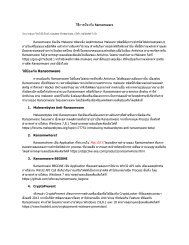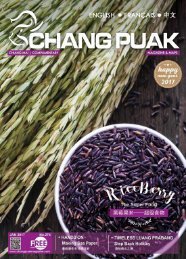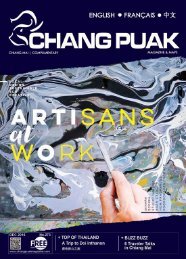Create successful ePaper yourself
Turn your PDF publications into a flip-book with our unique Google optimized e-Paper software.
At the Siam Celadon factory everything, from drumshapped<br />
seats and table bases to complete dinner sets,<br />
is made by hand. The factory houses many rooms,<br />
each one being devoted to one of the many steps in the<br />
process of celadon-making. First, local ball clay is prepared<br />
and formed into slabs for the potter. It is shaped into plates by<br />
women at work at a motorized potter’s wheel, using a knife to<br />
control the shaping.<br />
The production is a relatively long and complicated process.<br />
The most essential aspects of it are the use of the proper<br />
earthenware clay raw materials, proper drying, the use of<br />
highly skilled artisans in molding and design application, then<br />
in the glazing and firing processes. A small, comparatively<br />
simplistic design, either hand-painted or in low relief,<br />
usually takes four to six weeks to make well. A larger piece<br />
can take as long as ten weeks, although six to eight weeks<br />
is the average.<br />
Before drying, the pieces that are to receive applied<br />
decorations like leaves and flowers go to a liquid-slip artist.<br />
Pieces that cannot be thrown, such as coffeepots and<br />
figurines, are cast in the jiggers shed. Here, clay is poured<br />
into a mold and allowed to set and dry. The clay for a<br />
half-inch-thick wall sets for one and a half hours before the<br />
excess is poured out. After two days of drying in the mold, it is<br />
ready for the low - or biscuit - firing at 1,472 degrees.<br />
Next comes glazing. The piece is dipped into a mixture of<br />
wood ash and another local clay, different from the ball clay.<br />
The proportion of ash and clay determines the color of a piece,<br />
whether classic green, greenish-brown or the attractive<br />
blue that was introduced a while ago. If the article has a<br />
design, the first coat is wiped with a sponge so that it fills<br />
in the design and makes it darker. A second dipping takes<br />
place when the first coat has dried, and then a third coat is<br />
brushed on to smooth over any imperfections before the<br />
high - or glaze - firing at 2,372 degrees. The 10-hour slowcooling<br />
period gives Thai celadon its crackle.<br />
At Siam Celadon you can witness the different steps<br />
of the making of celadon and you can choose beautiful<br />
products in their showroom (prices are affordable). The art<br />
of celadon is a living art passed down from one generation<br />
to another but in our modern<br />
times it is becoming more<br />
and more difficult to interest<br />
the new generation in this<br />
work. Visit this beautiful<br />
factory to bring home<br />
unfogettable<br />
memories.<br />
从 清 迈 东 部 前 往 山 甘 烹 (Sankamphaeng) 的 路 在 地 图 上 标<br />
记 为 1006 号 高 速 公 路 , 可 它 为 当 地 人 熟 知 的 却 是 另 一 个 更 丰 富 多<br />
彩 的 名 字 —— 手 工 艺 品 路 。 因 为 道 路 的 两 旁 排 列 着 各 式 手 工 作 坊<br />
和 展 厅 。 在 这 里 , 您 可 以 看 到 泰 国 北 部 著 名 的 手 工 艺 品 的 生 产 流<br />
程 和 成 品 展 示 。 这 个 7 月 , Chang Puak 杂 志 将 带 您 去 探 访 “ 暹 罗<br />
青 瓷 厂 ”—— 当 地 著 名 的 一 个 青 瓷 工 厂 , 致 力 于 生 产 优 雅 和 极 具<br />
特 色 的 青 瓷 。<br />
根 据 泰 国 历 史 , 国 王 Ramkamhaeng 于 13 世 纪 访 问 中 国 首 都<br />
北 京 , 将 中 国 的 陶 器 和 陶 工 带 回 到 了 泰 国 。 今 天 在 清 迈 这 座 城<br />
市 , 手 工 艺 者 专 注 于 烧 制 青 色 及 蓝 色 的 瓷 器 , 当 然 黄 色 和 棕 色 也<br />
部 分 存 在 。<br />
“ 暹 罗 青 瓷 厂 ” 出 品 众 多 青 瓷 物 件 : 从 鼓 形 座 椅 、 单 桌 到 成<br />
套 餐 桌 全 都 是 手 工 制 作 , 价 格 也 非 常 亲 民 。 走 在 美 丽 的 工 厂 里 ,<br />
您 可 以 见 证 青 瓷 制 作 的 不 同 步 骤 。“ 暹 罗 青 瓷 厂 ” 会 是 您 在 清 迈<br />
能 找 到 的 一 个 美 丽 而 时 髦 的 去 处 。<br />
SIAM CELADON :<br />
38 Moo 10, T.Tonpao Sankampeang Chiang Mai<br />
Tel. 053-331 526<br />
www<br />
www.siamceladon.com<br />
38 39


